Q&A: How to avoid being squashed by a whale
How stars burn for billions of years. Can Rishi Sunak turn us into a nation of mathematicians? And how misinformation changes the shape of our brains. Plus, there’ll be our customary quiz at half time...
In this episode

00:52 - The Q&A Line-up
The Q&A Line-up
Tom Mustill & Ems Lord, University of Cambridge & Matt Bothwell, University of Cambridge & Leor Zmigrod, University of Cambridge
Chris - With me to help answer the questions that you are sending in is Tom Mustill. Now, he's an award-winning natural world filmmaker. He's directed some David Attenborough, including 'Giraffes - Africa's gentle Giants.' He's also an author. And I gather recently you've been diving into the underwater realm. Tell us more.
Tom - Well, I spent the last four years spending a lot of time with people designing underwater robots and using artificial intelligence to try and decode the communications of whales and dolphins.
Chris - Whales?
Tom - Well, yeah. I've got a quite weird link to whales. In 2015, I was kayaking and a humpback whale breached on top of me and dragged me and my friend underwater. And we were fine and the whale was fine, but I was already quite interested in whales. But that definitely made me more interested in whales.
Chris - My goodness. Because there was some very famous footage that made the internet of some people getting body slammed effectively by, because they weigh a lot, I mean, they are tens of tons, aren't they? Or was this a big one?
Tom - This was a big one. It was a humpback, it was an adult. The rule of thumb with humpbacks is you get about a ton per foot. And it was about 30 feet. So about 30 tons.
Chris - <laugh>. And do you know why it decided to come down on top of your kayak?
Tom - Well, this was the thing that I found most interesting as a zoologist by background and then a wildlife filmmaker was, when a whale jumps out of the water, it releases the equivalent of like 30 hand grenades worth of power. And no one knows why they breach. There were a lot of theories, but really they're just conjecture at the moment. We don't know why they breach at all. And the only thing we really know about that incident when it landed on us was that it probably wasn't on purpose because scientists analyzed the trajectory of the whale and they found that, in mid-air, it looked at us and it turned away and, intentionally moved away from squishing us and that's why we survived
Chris - Well, it's interesting that it would've had a concept that this would be potentially lethal for you had it splatted. Or was it thinking It was self-preservation - 'I don't wanna hit that hard looking thing.'
Tom - I think like the scientist in me thinks, well, the most rational thing is it sees a new object and wants to not hit it. But humpback whales in the last few years, there's over a hundred incidents where they've come to the aid of other species when they're in trouble and I witnessed this. I witnessed humpbacks pushing killer whales off a dead gray whale calf that the killer whales had hunted. And all over the world in all the oceans humpback whales interfere to try and preserve the lives of other species. So maybe there is some altruism in there too.
Chris - Well, Tom Mustill is with us, he's the author of 'How to Speak Whale.' He's brought a copy of his book in and he'll be answering questions and telling us about how whales communicate later on in the program. Next up, Leor Zmigrod is a psychologist. She's at the University of Cambridge. She's got a broad expertise in psychology, but she's very interested in extremism. Specifically, what are you interested in? Is this the area of sort of susceptibility to extreme beliefs? Are extremists sort of born, not made, or do they get converted by hearing the wrong thing? Is that the area you're interested in?
Leor - That's right. In psychology, we use a lot of methods from social sciences to try to understand what factors make people susceptible to radicalisation or to taking ideologies to an extreme degree. But I'm actually interested in the brain and what characteristics of your brain, of my brain might make us susceptible or resilient in the face of extreme ideologies.
Chris - So that's Leor Zmigrod, who is coming up later in the program. If you have any questions, obviously about that, you can put them to her. Matt Bothwell is also in, he's the University of Cambridge's public astronomer and he's also an author. 'The Invisible Universe - Why There is More to Reality Than Meets the Eye' is Matt's book. Now you were on this program almost the same time last year, Matt. And the conversation we were having then was the debate in your house about turkey and tinsel versus telescope because it was just after Christmas and the James Webb Space Telescope had launched and you said you sued Queen, you sued the Christmas table and you watched the telescope go up. So what's on your radar for 2023?
Matt - Well, more James Webb, t.o start with the last year has been a fantastic one for James Webb. Listeners might have heard that one thing that we were really concerned about as astronomers was the amount of fuel left for operations. Because it was the same fuel tank that was doing the launch and then would have to be up there steering the telescope. And it turns out that the launch was so precise we might have as much as two decades of James Webb and the first year has surpassed all expectations and we have lots and lots of exciting things coming in 2023. I think for me personally, I'm most excited about a satellite called Euclid, which is going to be launching sometime in the summer. It was gonna be launching earlier except it was gonna go up on a Russian rocket and sort of geopolitics intervened. But sometime between June and September I think Euclid's going up. And what it's going to do is measure the acceleration of the universe more accurately than ever before. And that's gonna give us all kinds of important information about how dark matter works and how dark energy works. And hopefully give us the keys to some very, very big questions indeed.
Chris - This is the issue that the universe, if we look far enough away, we see things retreating from us and the farther away we look, the faster they're going away. Evidence the universe is getting bigger all the time and it's understanding in more detail what is going on and putting some numbers on this.
Matt - Exactly. Yes. Wel it's a little bit more than that. So we've known that the universe is getting bigger and bigger all the time for about a century now. But around the year 2000 or so, scientists tried to measure exactly how fast the universe was getting bigger. We expected it to be slowing down, right? Like something slowly grinding to a halt. But it turns out it's the opposite. Something has its foot on the accelerator of the universe. The universe is getting pushed apart faster and faster and faster by some mysterious force that we don't understand. We call it dark energy. Astronomers use the word dark to mean I have no idea what this thing is, right? So, yes, we're trying to understand more about this mysterious force that seems to be pushing the universe apart.
Chris - One physicist said you put the word dark in front of anything you want a grant for.
Matt - <laugh>. It works very well.
Chris - <laugh>. Oh, well good, you said it. Thank you very much. Matt Bothwell also with us is Ems Lord who is the director of Enrich. She is Cambridge University's maths outreach program director. That's really relevant to you, I would think, what Rishi Sunk has said this week and wants to turn us all into a nation of mathematicians, he wants everyone studying maths to be 18. What do you think about that?
Ems - Oh, well, I mean, what a great week to be a mathematician. We're suddenly front page news. It's great that there is this conversation going on about mathematics and the study of it, but then you take a step back and just say, how will we deliver this? Where are the maths teachers for a start? We already have a shortage. Where are we gonna find them from to quickly deliver this? But also when you look at some of the research reports about why people don't carry on with maths, there's one in particular that really grabs the attention and the title 'I Would Rather Die' <laugh>. This is a study. Seriously, this is a study among teenagers, 16 year olds about why they don't wanna carry on studying maths and they would rather die.
Chris - They'd rather go boating with Tom.
Ems - <laugh>. So yeah, they don't mention the whales <laugh>, but you know, this is issue we have, it's the curriculum, the maths curriculum. We're teaching things that we maybe taught 50 years ago, that were relevant. And now we've learned through covid how important it is to have data literacy
Chris - Is he confusing numeracy with maths? Because when I saw, with the example you just gave and I saw umpteen newspapers on the last day since the Prime Minister said 'I want people studying more maths.' They're all giving examples of what I would call numeracy. The ability to understand when you are being ripped off, to understand how to get a good deal, how to work out how much carpet you want in your living room, but that isn't maths, that's an application of maths. That's being numerate. Maths to me is when you try to explore the relationships between numbers and interesting concepts, that's slightly different. So are they kind of selling this as maths and it's not?
Ems - Yeah, they're talking about numeracy and some very basic examples. What they're not talking about is understanding statistics. So if you hear a survey, 90% of people think this is a great idea. How many was the 90%
Chris - Yeah, How many people? Because if they interviewed 10 people and it was nine out of 10, okay, meaningful. If you interviewed two people, it's how you get to 90% for a start, and you know, it's going to be wrong.
Ems - And nowadays isn't that such an important skill to have when we're being bombarded with these images and these surveys. These things weren't happening 20, 30 years ago. We had a few years ago, Michael Gove going into schools when he was the minister.
Chris - This is the guy that said 'I want the majority of kids to be above average', right?
Ems - Exactly. Yeah. And this guy was so taken with the long division and how he learned at school. We suddenly have primary schools now teaching long division again, and yet we have calculators. Let's think about the numbers we are producing and have the number sense to interpret the data and use it to make good decisions. So if we're talking about having maths and becoming data literate, that's fantastic, but we need the funding and we need the teachers to make it happen.
Chris - I think we're gonna have a good programme and a bit of fun this week. So that's our panel. Thank you Ems, by the way

09:37 - Is behaviour genetically encoded into the brain?
Is behaviour genetically encoded into the brain?
Leor - Wow. What a big question. And I guess when we're thinking about how things are passed on genetically in terms of evolution and how that gets into our psychology, there are some overlaps between animals and humans, but there are also some differences. So with golden retrievers specifically, we know that they've been bred to retrieve. So the fact that they can do that very well is not surprising because their evolution has kind of been fast-forwarded to be able to do that really well. For humans, I guess the question is why don't we all retrieve constantly? And I guess it's a question of personality. We see even babies as young as a few days have personalities and temperaments. Some are irritable and some are calm and that's obviously not something that they learned. It was just something that they were born with.
Chris - But to the root of the question, does anyone actually know what's going on in the brain of a retriever that wants to retrieve versus a dog that just wants to run off and play? Have we got any insights yet into how genetics translates into brain structure that encodes these sorts of hardwired behaviors, a bird building a nest, for example, and knowing what to do about getting the right sticks in the right place and putting the nest on the right side of the tree.
Leor - So there's a whole line of research called comparative psychology or comparative cognition that looks at the skills that animals have and why they have those skills. And so for instance, we know that different kinds of birds and corvids are exceptionally good at problem solving and we know that different, like you said, different animals perform all these kinds of behaviors and actions and um, and things that really impress us. So why does that actually happen? I think that it's a really long chain of causes and effects. And I don't know if as a science we have it all down to one long trajectory that we understand. We know that our genes code for particular kinds of proteins, and that those proteins are then used in our biological functioning and that that gets translated into our whole way of living, and how animals behave as well. But the whole chain? I think that's a really big question.
Chris - Anything from the whale perspective, Tom?
Tom - Well, I'm not sure people know very much more about how whales convert their genetic programming or their neurochemistry or neurobiology into communication. But we do know that they pass on complex behaviors from one to another while they're alive. And researchers who study whales go as far as to call these cultures. So for instance, in sperm whale populations in some places, you have whales that look exactly the same to me or you. But when they come into contact with each other, different populations won't interact at all and they'll act in totally different ways. They'll forage in different ways, they'll defend themselves in different ways. They'll even communicate with different accents and what it seems like is different communication systems. And they learn these from one another. So if you were to take one of these whale babies away at birth and keep it by itself, it wouldn't do any of those things. Those things aren't instinctive, they're not programmed into them. And we really haven't been looking for a very long time at culture in non-human animals. And in the research that I've done, we seem to find it in more and more places. We find learned behaviors passed down from one animal to another. And combined with the emerging studies of animal personalities, one fox is not like another fox, you are getting a picture of much greater complexity in how animals do things and why they do things and how that differs between them than we thought there was before. And that can simply be explained by differences in genes or brains.
Chris - All fascinating stuff. Thank you very much

13:43 - What is number sense?
What is number sense?
Ems - Well, number sense is something that gets overlooked so easily. We mentioned before about long division, long multiplication, doing procedures, but when was the last time you're in the supermarket queue and you are trying to work out, did you have enough to cover the bill? And you went, 'oh, it's okay. I've got some squared paper, a pencil and a ruler. I'll just quickly do a bit of long division or multiplication and I'll figure the whole thing out.' Life doesn't work that way. You find yourself in a situation, you're at the petrol station, you're paying, you've gotta quickly deal with numbers and you've gotta have a feel for numbers and know you've got it right or wrong. And that's what we call number sense. So it's not just knowing the facts, it's having the confidence to play with it and recognize mistakes. So what I like to do is find out when it's gone wrong, okay? I like disasters, I like mistakes. And then see what we can learn from them. So what I've come up with is a top five IT disasters. These are projects where people have been incredibly ambitious and said, you know, we wanna go to Mars, we wanna have the biggest subs, we wanna have the fastest trains. So they're ambitious projects. These are projects that have secured funding. So they have gone through loads of different levels, as we all know when we try and get funding, not easy. So you've got an ambitious project, you've got it funded, and then it fails at the end in a very embarrassing way because of number sense. And quite often one of the things that happens is the conversion from metric and imperial.
Chris - A spacecraft that had a problem. Very expensive consequences. Well, you are nodding Matt, it's quite a classic one . Isn't there a difference between imperial and metric?
Matt - Yes, exactly. I think there was, I forget the exact details, I think it was a European spacecraft that was using a software program designed by Americans and the software program supplied an acceleration in sort of foot pound hectares or whatever stupid thing Americans use. And then the spacecraft interpreted that as a metric and crashed into Mars
Chris - <laugh> costly mistake.
Ems - $328 Million costly mistake, <laugh>. Two years development, nine month journey. They got it there, they got it into the Martian atmosphere and that's when they lost it. I mean, how much do you feel? You're sat there, following this for months. You've got an investment, a long term project, and it burns up at that point. I just can't imagine how those guys must have felt.
Matt - I know.
Chris - Very nasty <laugh>. Would being better at maths have spotted that though? If I had a bit more numeracy, would I necessarily. I mean these are bright people and if they don't spot that, why do you think a paucity of math's ability is the problem?
Ems - I think it's what we value. At the moment, what we tend to value is, 'did you get the right answer?' Okay, have you got an answer? Move on to the next one. Our exam system favors that. Even down in primary school you get a 20 question booklet. How quickly can you get it through? They aren't encouraged to check and look back and estimate. And the mistakes that I'm looking at, you could avoid through that. You could save your 328 million just by going, 'do you know what? Those figures don't look right'. But too often we trust everybody's figures and we don't sit down and go, 'do you know what?' That sort of sucking of teeth you might get when someone's doing DIY? You know, measure twice and you know, check it carefully.
Chris - I learned that the hard way. I do a lot of mechanical type stuff and, and I had to find out the hard way. You measure twice and cut once. You are nodding as well, Tom.
Tom - I just love this idea of Ems' number sense and the idea of questioning things because I think so many people get turned off many sciences when they're at school because there's an idea that you have to memorize what's right or wrong and it's only really where you get into doing your own research and you know a topic really well that you realize that most people aren't really sure of all the things that you learned at school and that the most exciting things are mysterious and probably most of the things that are thought to be right will be wrong at some stage in the future. And that's so much more exciting than proving whether your brain can remember stuff. This idea that, you know, for example in natural history, like we have so few explanations for so many of the things that animals do. And I think that's really exciting and I think many more people will be drawn into it with this idea that they can contribute and play rather than don't get it wrong.
Chris - Yeah, it's excitement for what we don't know rather than getting right just what we think we know.
Tom - Totally.

18:34 - How can stars burn for billions of years?
How can stars burn for billions of years?
Matt - It's a really good question. I think I'm going to give you an answer in two halves, I think. You wouldn't be alone in thinking they would burn up sooner. Around a hundred years ago, this was one of the real hot topics in physics. There was a famous physicist called Lord Kelvin around the start of the 20th century. He did a sort of back of the envelope calculation of how long the sun should last and came up with an answer of a handful of million years. He sort of imagined the sun burning like a gas fire or something and said, okay, it can last maybe 10 million years and therefore evolution has to be wrong. There's not enough time for animals to evolve. And he used that to argue against Darwin and of course he was completely wrong, right? The missing piece of the puzzle that he didn't understand was the process that the sun uses to create energy is called nuclear fusion. And it's extraordinarily efficient. You get an enormous amount of energy out of a really, really tiny amount of matter. Um, it's dictated by this very famous equation. E=mc squared. E is energy, m is mass, and c is the speed of light, which is a very big number. So C squared is an enormous number. So what e equals mc squared is really telling you is that a tiny, tiny bit of mass gives you an enormous amount of energy. Stars are very, very efficient. The other half of the answer is that stars are just really, really big. So even if they are churning through fuel at an enormous rate, they can still last a very long time. The sun burns through several million tons per second, which sounds unbelievable, right? You think that wouldn't be sustainable at all. But if you go and calculate it down maybe use your number sense, right? If you get a calculator to work out how many seconds in a year, multiply that by 10 billion years and multiply that by a million tons of seconds, you don't get to even a fraction of 1% of the sun's mass, right? So the sun can happily burn a million tons of seconds for billions of years and still be absolutely fine. And it's all down to the efficiency of E=mc squared.
Chris - One point though is that size matters when it comes to stars, doesn't it? Because if you are a very big star and you have a massive amount of fuel and a massive amount of gravity and mass driving it all together, you get very, very hot, very, very quickly. But you also burn off all that fuel much more quickly. So big stars burn faster and brighter than small stars.
Matt - Yeah, that's exactly true. It's almost counterintuitive, right? You would think ‘big star, more fuel, it would last longer’. But big stars really do sort of live fast and die young. They burn so hot, they burn through their fuel much, much more quickly than smaller stars. So a star like the sun, which is pretty small, would last about 10 billion years. That's about 10,000 million years, more or less. A massive star might last 10 million years, which sounds like a long time. It's sort of a blink of an eye compared to the sun. A little cold red dwarf star might last for longer than the age of the universe.
Chris - Thank you, Matt.

21:32 - Are certain people susceptible to extremism?
Are certain people susceptible to extremism?
Leor - So what we've seen in the research that I've done in the research a lot of people have done as part of this new field called political neuroscience, which is using neuroscience techniques to study our political ideologies. What we find is that there are some traits that we can measure in the brain, in our cognition. Traits that we can measure that we might not even know that we have, that we might not be able to self-report on what we are, and we can use those traits to infer who is most susceptible to things like radicalization. One example that I found in my research is a trait called cognitive rigidity. So we measure cognitive rigidity by basically getting you to play all these kinds of brain games where you're moving shapes on a screen or you're responding to all sorts of challenges. Some might be numerical challenges, some might be linguistic and language games. And what we see is that people who cling on to first impressions and then never manage to change or to switch or to adapt, people who are cognitively rigid, who mentally tend to stick to their first guns and then never change, even in tasks as simple as Tetris-like games. The more rigid they are cognitively and psychologically, the more that they're also rigid in their politics and in their ideologies. So that's one kind of factor that makes us susceptible to becoming radicalized to any ideology.
Chris - So that could work both ways then, because if they're not radical, they're not gonna be very susceptible to being radicalized. But if they are a bit radical to start with, then it's very hard to shake them out of it.
Leor - That's a great point that there is a kind of this paradox of flexibility and rigidity, right? If you are too rigid, you'll never let any new ideas in. Uh, but if you're too flexible, you'll kind of sway with the wind, whatever the latest opinion is, that's the fashion that you'll take onto. So there is kind of this middle ground in order not to be either too persuadable or too dogmatic.
Chris - There's been some criticism recently of the program that the UK government set up called 'Prevent', which was the idea being that you try to stop people becoming seduced by terrorist messages and extremist ideologies, for example. And people were saying that this was flawed. If we've got people in the population though, who are very rigid in their thinking, we know they all exist, but if they're already terrorists, or they have inclinations to become terrorists, does this mean that we really can't, with all the best will in the world make a programme work that will will change their mind?
Leor - I don't think so because there is a difference between vulnerability, which is like a potential state, and actuality, what you actually end up doing. So even if we have a population and kind of a large range of people who might be susceptible to ideological extremism or to becoming radicalized, that doesn't necessarily mean that they will. And so finding out who is vulnerable and how we can best support them before they end up being exposed to radical ideology, I think that that's important.

Q&A Quiz!
Tom Mustill & Ems Lord, University of Cambridge & Matt Bothwell, University of Cambridge & Leor Zmigrod, University of Cambridge
Chris - We are putting your questions under the microscope this week, and with me to do that, our nature filmmaker Tom Mustill, psychologist Leor Zmigrod, astronomer Matt Bothwell, and mathematician Ems Lord. Coming up, we'll find out a bit more about whales and how they communicate. We'll ask whether we can vaporize space junk and we'll learn a bit more about the mathematical marvel that is modeling and that's modeling the numbers, not with the human body, which will be bad in my case. Now it is time to test the mettle of our teams, because we do this in the middle of these Q&A shows where we go off piste and test the general scientific knowledge of our participants. And you are competing, you lot, for a prize beyond price, which is the Naked Scientists Big Brain of the Month award. Team one is going to be Matt and Leor. Team two are Ems and Tom. And, to our two teams, we actively encourage you to confer. Now, Matt and Leor, first question number one - who won the inaugural Nobel Prize for physics in 1903 for discovering x-rays? Was it Walter Muller, John Sealy Townsend, or Wilhelm Röntgen?
Matt - I think it was Röntgen. I think he x-rayed his wife's hand and there's this really famous picture where you can see her wedding ring really standing out. So unless I'm thinking of the wrong one, I think it was Röntgen.
Leor - Okay. I think that the fact that you're a physicist means that we should definitely go with that. And I like the story, so that sounds believable to me.
Chris - <laugh>, you're going with Röntgen and it is a <Ding> bing bong for there. You're absolutely right. I had an interesting run in with X-rays, in fact, because about 15 years ago we won an award in the late noughties in those days when the Naked Scientists won awards and they flew us to LA to go and get this award. And while I was there, I'd read this paper in one of the big science journals the week before. This chap at the University of California, Los Angeles had said he could make x-rays with sticky tape. And while Wilhelm Röntgen did it by exciting electrons in wires, what Carlos Camara was doing was unwinding reels of sticky tape in his laboratory in a vacuum at very high speed in order to produce x-rays. And he just discovered this by accident. And we walked into the lab and he's got piles of scotch tape boxes up to the ceiling. And he'd got this metal sort of vat, which he'd created this device to have a sticky tape reel on one spindle, another one on another, so he could wind sellotape on and off of the spindles very, very quickly in a vacuum. And they could produce this intense beam of x-rays out the top of this thing. And they were doing it so well, they could do exactly what Röntgen did and take x-rays of their hands. And, and I then looked up and I said, well, 'you are on the ground floor. Who's in the lab up there?' And he sort of looked at me and smirked a bit and said, 'I dunno, but I doubt they're fertile anymore.' <laugh>, these x-rays going through the floor. One mark to Matt and Leor so far. Well done to you. Question two, this one is to team two Ems and Tom. Which of the following types of electromagnetic radiation has a shorter wavelength? This round is called 'X marks the spot', So we're talking about Xs. Which of the following types of electro maintenance radiation has a shorter wavelength than x-rays? What do you two think? Gamma is A, ultraviolet is B or microwaves C.
Ems - Oh wow. This is definitely not my area of expertise apart from probably the length of the wave.
Tom - I mean, the only wavelengths that I know are one's in the sea.
Ems - Okay, I mean we can do it the mature way - Scissors, paper, stone.
Tom - <laugh>
Chris - Gamma rays, ultraviolet, or microwaves. A, B, C, which do you think it is?
Ems - We go for the first one?
Tom - I'm with you Ems.
Ems - Okay, we'll do this very scientifically and just go for the first one.
Chris - The scientific guess. It's a scientific guess and it is <DING>
Tom - Yes!
Chris - Not that you're competitive or anything.
Tom - No, it was just relief.
Ems - We're just trying to keep up here.
Chris - Good. So we are level pegging as we go into round two, which is called 'Elementary, my dear Watson.' And that's because this round is all about the periodic table of elements. So Matt and Leor, your question. There are two letters that don't appear as symbols on the periodic table. Q is one of them. What is the other letter? It's not Q, there's one other. Is it J, W, or Y? What do the pair of you think? Which letter is not represented? J, W, or Y? Other than Q?
Matt - It's not Y. I think Yttrium starts with a Y, right? I, I can't think of a J. Can you?
Leor - I cannot think of a J. What was the other, what was the third one?
Chris - J, W, or Y.
Matt - I feel like some of those ones down the bottom in the period on the table, one of them has to have a W in it. I dunno. <laugh>.
Chris - So you're going for...?
Matt - I don't know. My vote is J, what do you reckon?
Chris - Leor, J?
Leor - Okay, let's go with J.
Chris - It's a good idea because you're absolutely right. Plus one for you. Yes, it is J. J and Q are not used as the letters in periodic table elements. Y is Yttrium, you were quite right there. Actually W does exist. It's not one of the rubbish bin category actinides and lanthanides at the bottom. It's Wolfram, which is what was originally Tungsten. And Tungsten got rebranded by IUPAC, the organization that gives the chemical elements their name. About seven decades ago. The Americans lobbied to change the name to Tungsten, which is actually Swedish for heavy stone because the Swedes who discovered tungsten and called it Wolfram got it out of a heavy stone. Tungsten <laugh>. And so they called it Tungsten and then it got called Wolfram afterwards, then back to Tungsten again. So you're quite right, it was indeed J. That's not the other one that's in there. Right, plus one to you two. Ems and Tom, Team two. A synthetic element. A synthetic element is one of the 24 known chemical elements that don't occur naturally on earth, or they're only present in minuscule amounts. So, what was the first such artificial element that was created - A, uranium; B, americium; or C, plutonium?
Tom - Is uranium actually naturally occurring in some places?
Ems - You mean uranium, I'm thinking back to the Second World war.
Tom - Would you have thrown any actual real non-synthetic ones in there? Would that be a sneaky thing that is feasible?
Chris - I'm pulling my poker face
Ems - Cruel.
Chris - Is it A, uranium, B, Americium, or C, plutonium.
Tom - I've never even heard of Americium.
Ems - Same here.
Tom - But it makes it sound like it's going to come later and two of them are radioactive. So maybe one of them, the answer is one of the radioactive ones.
Ems - Okay. I kind of like reasoning.
Chris - Going to have to rush you.
Tom - This is a psychology of question setting rather than any chemical knowledge.
Ems - First thing you talked about was plutonium. Should we go for that?
Tom - I don't don't want it because I think I'm gonna be wrong, but sure.
Ems - Okay.
Chris - Plutonium? <DING>
Ems - There you go.
Chris - Oh, there's a high five going on.
Tom - My chemistry teacher is turning in his grave right now.
Chris - Most well known for its use in atomic bombs and nuclear reactors, Uranium is naturally occurring. And in fact it was used as early as 79AD by the Romans who were using uranium to color glasses. They made beautiful glasses with that. Americium, you said 'I don't even know what that is'. Americium is artificial. It's in smoke detectors. You'll find it's an alpha source, which is in pretty much every home in developed countries now where it's used to detect the particles of smoke, which get in the way of the alpha particles it's giving off.
Ems - A sneaky question, but I think we've just learned a lot there.
Tom - Yes.
Chris - Excellent. Well you're doing well because it's level pegging. So we're onto round three and Matt and Leor it's back to you. This one's a tough one, excuse the pun. A rhino skin makes up a quarter of its body weight. Is that true or false?
Leor - I can imagine. Do you have an intuition?
Matt - <laugh>. I can imagine it being true. Because I know human skin makes up a surprisingly large fraction of our body weight, right? And you know, rhino skin is more substantial than human skin, so it doesn't seem crazy on the surface. I can imagine it being true.
Leor - Do they also have tusks? That would be really heavy though.
Matt - That's true. Yeah. No, well they have horns, right? But I don't know if they weigh a quarter.
Leor - Yeah, I mean I think it sounds plausible.
Matt - I'm happy to say yes because I want it to be true.
Chris - So you're going, true.
Matt - Yes.
Chris - I actually get to use a different button now. <BZZT>
Matt - Oh no.
Chris - You got boobed I'm afraid. No. Do you think it's bigger or smaller? The number?
Tom - Oh, is It bigger?
Chris - Well, it is, yeah. We are told by Will Tingle, who is our producer. <affirmative>, I said have we fact checked this because I was skeptical. Apparently 43% of the weight of a rhino is it's skin.
Matt - Oh wow.
Chris - Do you know what the equivalent is for a human? Tom? You're the animal person. So what is the equivalent for a human? The proportion of your body weight that is skin, would you say? No bonus points.
Tom - Well, it depends on how deep down you go, but maybe like 4%, 5%.
Chris - Apparently it's 12.4% for the average mammal. Maybe in Wales, because of all the blubber it's gonna be a bit more, but yeah in the average mammal it's 12.4%. you didn't get it on that one. So it all depends on you. You could take this Ems and Tom, if you're able to pull this one off. Herewe go. So, this question also in numerically speaking round three, what is greater - the number of nerve cells in the brain or the number of stars in the Milky Way galaxy?
Ems - Ooh. Now if we can only recruit another team member temporarily, we would be well here.
Tom - Yeah. Have you got a good feeling about this? Have you? <Laugh> I mean, a fact that I always find a bit frustrating is that people say that the human brain is the most complicated thing in the universe, which I always find frustrating because sperm whale brains are much bigger. I mean, I'd be tempted to go with brain. Do you reckon there's a lot of them packed in there?
Ems - There's certainly a lot packed in there because you see all the problems that happens when these things start failing us as we age, don't you?
Tom - Yeah. Not my brain. Can we have the brain of an 18 year old university student? Yep.
Chris - Yeah.
Ems - Yeah. A fresher.
Chris - A fresher, okay, so what are you going to go for? Brains or stars, have got a bigger number of things.
Ems - Let's go brains.
Tom - Yeah, yeah.
Chris - You're going to go brains. Yes. Oh <BZZT>
Tom - No!
Chris - Oh no. It's actually A, stars. We estimate, and Matt will hopefully corroborate my figure, that there are somewhere between a hundred and 400 billion stars in the Milky Way. We're not entirely sure, but we have a closer idea about the brain because we can actually look at that more easily. It's a more practical problem. There's about 86 billion neurons.
Tom - So you are saying we don't totally know that.
Ems - It's an estimate. They're using their number sense.
Chris - It's a guesstimate.
Tom - I'd say the number is still out there. You need another noise
Chris - Well, what's out there is the opportunity to play for this tiebreaker, which everyone's involved in. Now don't confer because you'll give the game away to the other team. I will, at the end of a 30 second thinking period, after giving you three clues, come to each of you in turn and the first person to get it right is gonna clinch it for their team. So here we go. In which year did the following scientific breakthrough occur? Edmund Hillary and Tenzing Norgay Summit Everest for the first time. Any takers so far? Don't say the answer. Just say it if you think you know the answer. Leor, have you got an idea?
Leor - Nope.
Chris - Matt thinks he might have the idea.
Matt - If we get it wrong, do we get another go?
Chris - You don't get another go, but do you guys reckon you know, or do you want a second clue? You're going to take a chance? You guys okay? Tom? Would you reckon?
Ems - Yeah? We think it's '53
Chris - And you are absolutely right. It is 1953. Bravo.
Tom - I remember the magazine cover <laugh>
Ems - It was the coronation year as well.
Chris - So the big brain of the weekend month award this month goes to Tom and Ems. Very well done. We'll give you a round of applause. They were very impressive. <Applause>
Ems - Thank you very much.
Chris - Well done indeed. Right, let's get back to the questions.

Is maths ability innate?
Ems - I think it comes down to nurture, environment and opportunity. I worked for a while as a gifted and talented consultant and we were looking at how to encourage different types of skills. And one example was trombone playing. Now you could be lucky and grow up in a family where there's a trombone and get curious. Or you could be in a school where the music teacher takes them in and everyone gets a go. How do you know you're good at something if you haven't actually had the opportunity? So it's not just down to one thing. I think it's down to opportunity as well.
Chris - Well put. I agree. I think that it is about finding the person who's got the keen will and drive to want to do something and giving them the push and the chance to see how they get on, isn't it?
Ems - It's multifaceted and it's making sure we provide those environments. That's our responsibility to do that for the next generation.
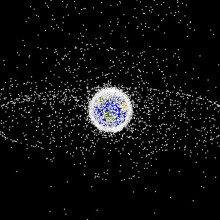
Can we vaporise space junk?
Matt - The answer is, hopefully. Space junk is a problem and it's only going to get worse. There's this positive feedback effect you have with space junk where if two bits of space junk crash together, they fragment and then suddenly you have a hundred bits of space junk that you didn't have before. And so if you cross a critical threshold, you can end up with so much space junk getting into orbit which could be really difficult. So we have to do something about it and part of the solution is going to be tracking it with these radio telescopes. I think you're talking about the square kilometre array in Australia, but there are different plans to get rid of the space junk and powerful space lasers are one of the top possible solutions. A slightly more popular option these days is to use a slightly less powerful laser to just heat the space junk until it changes its orbit, then burns up in the atmosphere. That's got the wonderful name - it's called a laser broom. I think the idea is to use the laser to sweep the orbits clear by making everything burn in the atmosphere.
Chris - That phenomenon of giving things a push with light also has a fantastic name, doesn't it? It's the YORP effect, which I learned about from a scientist who was studying how asteroids get pushed around by photon pressure from the sun. he said, Yarkovsky, O'Keefe, Radzievskii, Paddack effect, after the four blokes who discovered it. And I I said, I'm going to remember that because it's so fantastic. And here I am about 20 years later recalling that bit of information. But that's basically the same thing, isn't it? You give things a big burst of very powerful light, lots of photons, and they impart momentum and give it a push?

How do animals communicate?
Tom - Well, it's a brilliant question and one that people are looking into at the moment. A big problem is that we haven't really been looking at animal communication or non-human communication for very long. And we've got a lot of difficulties in even discerning it. We can't hear all the sounds, we can't see all of the things that are happening. We can't be everywhere. And there are communications taking place in the soil, communications taking place in the sea. But, saying that, of the communications that we have seen, and I know I'm biased, the communications of some citation species seem to be highly complex and complex in ways that are quite similar to the ways that we think of our language as being. This isn't to say that they have language, but whales and dolphins live a really long time, some species up to 200 years. Many species live in highly complicated social groups they need to hold together by communicating. And because they live in the sea, the best method of communicating is with sound. And over the last few decades, we've been starting to record a lot of these sounds and we've found there are lots of different kinds of sounds and the sounds are used really differently in different situations. Some of the simpler sounds we think might be things like, in some species of dolphin for instance, signature whistles, which is analogous to a name. A baby bottle nose dolphin would slowly learn its own signature whistle and then that would only be used by it and the other dolphins that know it when it's around, and they've even done experiments where they've noticed that dolphins separated from their social group and then reunited - the other dolphins remember their signature whistle, their name.
Tom - But it's really hard to understand the complexity of another animal's communication systems as a human being because our whole understanding and way of describing communication is based on our own. And that's where, at the moment, there are some really exciting studies going on using artificial intelligence, machine learning, as a way in. Because we've run analyses on human language using the software behind Google Translate, for instance. Google Translate doesn't know how to translate between one human language and another. It's just given enormous data sets of written or spoken human speech. And then it makes a huge array of all the relationships between the words and how they're used in these massive data sets that no human could ever spend the time to listen through or read through. And then it finds invisible patterns in human language and it uses them to translate between one human language and another. And that's what's really exciting lots of zoologists at the moment because these tools give us a way into other animals communications. And the first animals that the zoologists are choosing to go after are sperm whales. And there's a huge project in Dominica to try and decode their communications.
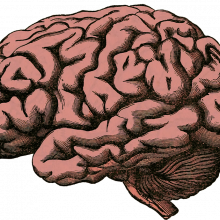
Do our thoughts mould our brains?
Leor - That's a great question because, in essence, sometimes we forget that our beliefs are part of our brains, they reside in our brains, our beliefs are an extension of us because where else would they be? So when we're thinking about this in the context of how information can affect our brains and our brains affect the kind of information we're receptive to, we can definitely see those bidirectional links whereby some individuals are highly attracted to certain kinds of information and their brains will soak it up. And at the same time, the kind of information that we're exposed to, whether it's extreme information in scary settings, or the environments that we're positioned in, that can sculpt our brains too in the way that any other kind of experience can. The same way that stressful experiences or adversity will change our brains, so will the kinds of information that we're embedded with, the kind of information that we inhabit and internalise deeply.
Chris - I think it was Susan Greenfield who said, the brain you go to bed with is not the brain you got up with this morning, structurally.
Leor - That's right. So many processes take place in our brains all the time. Our brains are never silent. They're never the same one day to the next. And so of course the information that we will take in and how we will process it will affect our brains all the time.
Chris - Although, there are limits on how plastic or mouldable our brains are, aren't there. And there's this question of, as you get older, whether you lose some of that?
Leor - We see that young people do have the greatest brain plasticity and that that does get reduced over time. But we can always improve, train. The more that we engage in flexible and creative acts that stretch our brains in all sorts of directions, the more that we can sustain that plasticity and flexibility over time.

Are space races best for progress?
Matt - I think this is a question that I would also love to know the answer to. I think the answer is that the people that are deciding that it's a competition are the politicians. It's not the people actually doing the science. NASA is famously beholden to this thing in US legislation called the Wolf Amendment, which means that they can't put any money into any sort of collaboration with China. I think the politicians' justification for this is that travel and space launches, in terms of tech, isn't a million miles away from missile launches. And so if you give people insight into your space capabilities, you might be giving them a bit of insight into your military capabilities. I think most scientists just want to get on with it, to be honest. I think Martin Rees, the astronomer royal here in Cambridge, said that America going along with this wolf amendment and refusing to cooperate with China was a huge own goal, and I think most scientists would agree. I think scientists tend to want to collaborate, right? Even at the height of the Cold War, you had mathematicians sneaking across the border to exchange their number theory notes and stuff like that, right? So I think scientists want to collaborate, even if sometimes politicians don't let us.
Chris - But also, it's a sort of friendly competition against frenemies up to a point, isn't it? It's quite good sometimes to have competition and regard yourself as in a race because it tends to make people dig deeper and go that extra mile. Things tend to get done faster if people think they're racing for something?
Matt - That's exactly true. So the the first space race between the USSR and America wouldn't have happened if they weren't in competition? There's a famous quote, I forgot who said it, that war is the continuation of politics by other means. I mean maybe the space race is a continuation of war by other means?
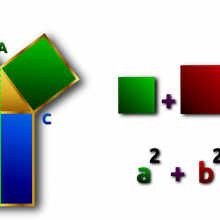
How can I perk up Pythagoras for my students?
Ems - Oh wow. Pythagoras happens to be one of the subjects that I studied at uni. I got fascinated by all the different ways that you can actually prove Pythagoras' theorem. There's a lot.
Chris - Just for those not in the know, you have a triangle that's got a right angle on one side, and if you add the square of one side plus the second side, then they add up together to the square of the long side. Okay, so that's what he's saying.
Ems - Yeah. That's great because we've got that procedural fluency; we know the rule. But the thing is, do we actually understand what it means? And I think there's a huge difference there between being able to recite it and understand it. The teaching is focusing on the understanding. Now there was this great geometry teacher and what he did is he drew the triangle on the board, the right angle triangle, and then on each side of it he drew a square. Now imagine you've got those squares and you've made them out of gold. So you've got three squares of different size, you've got one along the hypotenuse and you've got squares off the other two sides. Now, if you want to engage your students, why not offer them which one they want? Do you want that single square or do you want the two smaller squares? Now, if the class has really understood what Pythagoras is about, they're going to know it's no contest.
Chris - It must be the same.
Ems - But what happens when you do that with a class? They tend to go for the larger square. Now part of that might just be, "I want the biggest, it's mine", put my arms around it. But it's also saying something about the understanding. So I think choosing activities like that where it goes deeper into the understanding, the conceptual understanding, rather than just focusing on the fluency. Yes, we need to know the facts, but there's no point in knowing them if you can't apply them. You get builders nowadays, they'll talk about having a 3, 4, 5 to get your roofs correct at the angles. And they may not associate that with Pythagoras, which is a shame. Here we have a system at the moment where people are saying they don't understand why they do maths at school and somebody's going, "I want to go off and be a builder. Why do I need Pythagoras?" And then they'll go and use a 3, 4, 5 to try and get the roof right.
Chris - You're so right though, because I can remember, I must have been about eight, nine years old and my maths teacher was trying to introduce the concept of area. And when you are that age when someone has centimetres or metews squared, it just doesn't really mean anything to you until she said, "I'll tell you the story of a monk who used to walk around the courtyard at the monastery and all four sides of the cloister." And the cloister was paved in one metre wide flagstones. And he found out that he could work out exactly how many there were and the area of them if he walked and counted them, or he could do it the quick way and times that side by the number along that side. And that vivid picture that it created in a seven, eight year old brain meant I engaged with it. And rather than it being foreign language, "metre squared, centimetre squared, what on earth does that mean? Oh, now I actually can understand what this is about."
Ems - And you've got a visual there. And visuals are so important in mathematics. We go throughout mathematical history and when we've got the visual, we've often made the breakthrough. A really famous example is Florence Nightingale. There she was in the Crimea, lots of soldiers injured, but many more were dying of their wounds and she was trying to campaign for better conditions for them. And so she collected the data, had all the lists, and you think, as a mathematician, you've got it sussed: you've got the data, you present it and you win the argument. But they were just lists of numbers. And until you bring it alive and do a visual, which is what she did with an area map, you suddenly realise the huge number of casualties. So it's another example, if you do a visual, either someone walking around a courtyard, do you want the gold on the larger square, or is it the area of the soldiers and the ones who died from wounds? All of these visualisations are really important. So many people just think of maths and instantly think of algebra and X. And I think that's the case in many subjects, you start studying one thing and then, in order to achieve your goals, you move into something else. I started off studying mathematics and then I moved into mathematics education when I realised in the UK only 6% of professors of mathematicians are female. What's happening to all those others? It's our most popular A level subject but we're not converting it into female mathematicians. Think of the talent pool we're losing! So I think once you've got a problem or a challenge, you try to address it, you get those skills and then you can move into those things.
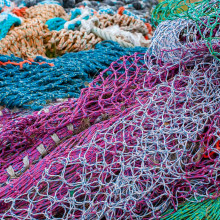
What is the biggest threat to underwater life?
Tom - This is a very hard question to answer because those three problems, which are just some of the problems that living creatures face in the oceans, they really depend on what kind of animal you are, where you live, and what kind of timescale you measure it over. So you can overfish a reef and then stop fishing and then that reef can be recolonised often and within a few generations you can have a vibrant community. But it can be absolutely devastated if you really overfish all the places around nearby or if you fish things to extinction, they can't bounce back from that. Plastic pollution - I've seen the impact of whales getting tangled and dying because they're caught in ghost nets and other plastic pollution. We can measure that very well. But what we can't measure, or not really understand yet, is what happens to all the microplastics that are so ubiquitous.
I think recently we found they could cross the blood brain barrier? These are going to be generational effects and they could be things that we can't measure or can't fix until they're too late. And with climate change, there are already winners and losers in the oceans emerging. In whales, for instance, in Antarctica, as the ice melts, that's making some places available to whales that couldn't really navigate around ice or weren't really comfortable. So their populations are going up, but other whales are losing the crill that they've fed off, or they're less comfortable in those warmer waters and they're having to move. So that's a really bad answer to the question because I don't know, but all of these things are so interlinked and they depend on where you are and the scale of the problem where you are.
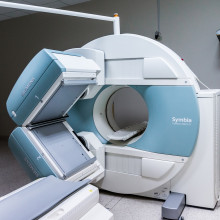
What are hallucinations?
Leor - So hallucinations are sensory experiences that are not rooted in any external stimulus. So there is no outside event actually happening, but the person is experiencing maybe an auditory hallucination where they're experiencing voices and similarly there's visual hallucinations or tactile hallucinations. And it's interesting to think about why the brain hallucinates and what the brain looks like when it hallucinates. And actually, insome of the research that my colleagues and I have done, we've looked at what a hallucinating brain looks like in the brain scanner and we wanted to know whether a visual hallucination that you see looks the same to the brain as an auditory hallucination. And we had this hypothesis, this theory, that there would be one area in the brain that would be able to distinguish between real and unreal information. So basically, would it be able to distinguish between a hallucination and a real sensory perception. What we did find is that the brain, the hallucinating brain, looks exactly like the perceiving brain. And that's fascinating that the brain doesn't seem to actually distinguish for itself between a hallucination and a real event.
Chris - Goodness. So when people say that it really seemed real to them and they're unshakable in their belief, if you try and dissuade someone who's having a hallucination that it's not real, that's why they so strongly disbelieve you, because to them it really is exactly the same brain wiring firing off as when they're having that experience for real. Which is why it feels real to them.
Leor - Exactly.

What's the hardest part of filming wildlife?
Tom - Well, you don't record all the time. There's actually a really neat function on many film/video cameras where when something happens and you press record, it will also save the previous five or 10 seconds or 300 frames or a thousand frames if you're rolling at high speed. So you don't need to record all the time if you've got that function. In the 'making of's, the behind the scenes, often you see people waiting, and people often say, 'well you've got to be very patient.' My experience has always been that, if you're in the lucky position that you are just waiting, that's great, because most of the time one of you has got a maggot hatching from your skin or you've forgot to charge the batteries, or the animal has migrated somewhere else, or your visas haven't come through or you've dropped the camera in a lake.
If you've actually managed to be in the right place at the right time and all you've got to do is wait, and plus there is a certain self-selection that the kind of person who becomes a wildlife camera person is probably quite happy by themselves waiting. but I mean there's a lot of, of uncomfortable. I mean, I made a documentary about called the Batman of Mexico where we went and filmed bats and that was really the main challenge there was that humans are awake in the day and bats are awake at night. So we just got really tired. And if you have to spend time in bat caves, you're basically sitting underneath them while they're defecating and urinating continuously. And the caves are often full of cockroaches, and we were just wearing flip flops and shorts and vests because it was incredibly hot.
But we were wading through knee high guano and there were centipedes on top of it and sometimes we filmed the snakes that were catching bats and we had to lie in pitch darkness and the only person who could see was the camera operator. We didn't want to disturb the bats, so we had to film with a wavelength of light they couldn't see, but we couldn't see that either. So he could just see all these snakes coming out of the walls and dangling around our heads and so all we could hear was him groaning in terror and we could just imagine it. But that's all kind of fun if you like that kind of thing. But each animal has its own challenges and I think the people who are drawn to film those animals often kind of like those challenges.
Chris - I think you've just done wonders for just drawing people into being a wildlife photographer.
Tom - Well it's a highly competitive field and if I've put anyone off, I'm delighted because it'll just extend my career. No, it's really nice. Join in.










Comments
Add a comment